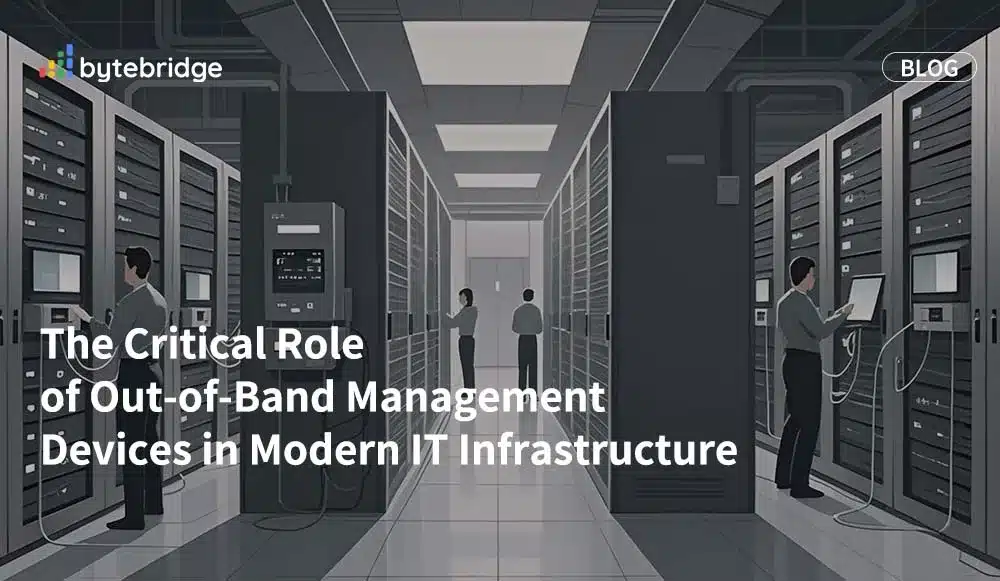Understanding Out-of-Band Management Devices
Out-of-band management (OOBM) is a method of remotely controlling and managing critical IT assets and network equipment using a secure protocol connection through a secondary interface that is physically separate from the primary network connection. This means that even if the primary network becomes unavailable due to outages or other issues, administrators can still access and manage their IT infrastructure.
OOBM devices, also known as out-of-band serial consoles or console servers, create an entirely separate, parallel network dedicated to the management, orchestration, and troubleshooting of production network infrastructure. They connect directly to networking devices via the serial port, enabling remote access that doesn’t rely on IP addresses. This allows administrators to access and troubleshoot devices even when the production network is offline.
Benefits of Out-of-Band Management Devices
- Remote Access and Troubleshooting: OOBM devices provide continuous access to infrastructure components even during network outages. This enables administrators to remotely diagnose and resolve issues without the need for on-site visits, which is particularly valuable in distributed environments where physical access to each device is nearly impossible.
- Enhanced Security: By isolating management traffic from production networks, OOBM solutions reduce the attack surface and protect critical systems from unauthorized access. Advanced security features such as role-based access control and encrypted communication help organizations meet regulatory compliance requirements while safeguarding sensitive data.
- Improved Operational Efficiency: OOBM enables remote monitoring and troubleshooting for all infrastructure components, including switches, PDUs, and other infrastructure that supports AI. IT teams can diagnose and resolve issues quickly, reducing mean time to recovery (MTTR) and minimizing downtime.
- Cost Savings: Organizations implementing OOBM solutions see significant gains in operational efficiency and system reliability, which translates to cost savings. For instance, ZPE Systems’ customers often report that their Nodegrid devices paid for themselves after just one outage.
- Network Resilience: OOBM solutions ensure network resilience by providing a dedicated pathway for monitoring and managing IT infrastructure. This is especially important for edge AI devices deployed in remote or hard-to-access locations.
Key Features of Out-of-Band Management Devices
- Multiple Remote Access Interfaces: OOBM devices offer various interfaces such as 5G/4G LTE, Fiber, and Wi-Fi to ensure 24/7 availability even during ISP or WAN outages.
- Legacy and Mixed-Vendor Support: Many OOBM devices support legacy pinouts and flexible port configurations, allowing organizations to manage and automate other vendors’ hardware without expensive adapters or complicated configurations.
- Integration with Third-Party Tools: Some OOBM devices support integrations with third-party solutions for identity and access management (IAM), two-factor authentication (2FA), and Secure Access Service Edge (SASE).
- Automation Capabilities: Advanced OOBM solutions provide predictive analytics and automated alerts, helping administrators identify potential issues before they escalate.
Market Overview and Key Players
The out-of-band management market is populated with several key players offering robust solutions. ZPE Systems stands out with its Nodegrid out-of-band management devices, which are recognized as the world’s first Gen 3 OOBM solutions. Nodegrid devices support up to 96 serial devices via 5G/4G cellular, Wi-Fi, POTS, or fiber. They can run Docker containers, VM applications, and any third-party applications, including security, automation, and orchestration solutions.
Other notable solutions include the Vertiv Avocent ACS8000, Lantronix Uplogix LM83X, Perle IOLAN SCG LWM, and Opengear OM2200. Each of these devices offers unique features and capabilities, catering to different enterprise deployment needs.
Applications Across Industries
- Data Centers: OOBM is crucial for data centers to ensure continuous operations and rapid recovery from outages. Nodegrid devices are widely used in large-scale data centers for their ability to manage and automate complex infrastructure.
- Edge AI Devices: Due to their deployment in remote locations and involvement in critical processes, edge AI devices benefit significantly from OOBM. ZPE Systems’ Nodegrid devices are ideal for managing NVIDIA’s SuperPOD architecture, supporting various components such as Supermicro HGX H100 GPU SuperServer and NVIDIA QM9700 1U NDR 400Gbps InfiniBand switch.
- Branch Offices and Remote Sites: OOBM solutions enable centralized management of remote sites, reducing the need for on-site visits and improving operational efficiency. ZPE Systems’ Nodegrid Gate SR combines branch gateway routing and OOB serial console functionality for remote business sites.
Market Growth and Adoption Trends
Recent reports indicate a growing adoption rate of OOBM devices across various industries. According to a 2023 study by MarketsandMarkets, the out-of-band management market is expected to grow from $1.2 billion in 2023 to $1.7 billion by 2028, at a CAGR of 6.8%. This growth is driven by the increasing complexity of IT infrastructure and the need for reliable remote management solutions.
Conclusion
Out-of-band management devices play a vital role in modern IT infrastructure by providing reliable remote access, enhanced security, and improved operational efficiency. As organizations continue to expand their IT environments and adopt more distributed architectures, the importance of OOBM solutions will only increase. ZPE Systems’ Nodegrid devices stand out as advanced, vendor-neutral platforms that support a wide range of third-party tools and scripts, making them a preferred choice for hyperscalers and global enterprises.
Embracing OOBM technology is not just a strategic move for businesses but a necessity to ensure network resilience and minimize downtime in an increasingly connected world.






